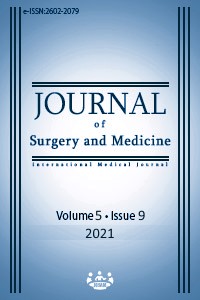Evaluation of sinonasal complaints in obstructive sleep apnea
Keywords:
Obstructive sleep apnea, Sinonasal complaints, Apnea-hypopnea indexAbstract
Background/Aim: Sinonasal complaints are frequently observed in patients with obstructive sleep apnea (OSA). This study aimed to correlate the severity of OSA with sinonasal complaints. Methods: A total of 90 patients, including 30 patients with mild, 30 with moderate, and 30 with severe OSA, were enrolled in this cross-sectional study. None of the patients received any treatment for OSA at the time of enrollment. All participants were asked to complete the SNOT-22 questionnaire. Subdomain scores obtained from the patients with the SNOT-22 questionnaire, total scores, and scores obtained for each complaint were investigated for any correlations with severity of OSA. Also, mild, moderate, and severe OSA groups were compared with each in terms of these scores. Results: A significant, positive correlation was found between AHI values and “nasal obstruction,” “runny nose,” “lack of a good night's sleep” and “waking up tired” items of the SNOT-22 (P=0.008, P=0.022, P=0.037, P=0.005, respectively) and nonrhinologic otolaryngologic subdomain scores (P=0.036). A significant, positive correlation existed between the severity of OSA and sleep subdomain score (P=0.039) and the total score (P=0.047) in addition to all the above-mentioned elements. There was no difference between mild and moderate OSA groups in nasal obstruction and runny nose complaints (P=0.858, P=0.990, respectively) but a difference was noted between mild and severe (P=0.016, P=0.011, respectively), and moderate and severe OSA groups (P=0.015, P=0.011, respectively). While there was no difference between mild and moderate (P=0.268), and moderate and severe OSA groups (P=0.036) in terms of the 'waking up tired' item, the mild and severe OSA groups differed significantly (P=0.009). Conclusion: OSA causes various sinonasal complaints such as nasal obstruction, runny nose, and waking up tired. An increase in OSA severity leads to an increase in these complaints, and treatment may lead to increased quality of life.
Downloads
References
Sforza E, Roche F, Chapelle C, Pichot V. Internight variability of apnea-hypopnea index in obstructive sleep apnea using ambulatory polysomnography. Frontiers in physiology. 2019;10:849.
Rashid NH, Zaghi S, Scapuccin M, Camacho M, Certal V, Capasso R. The value of oxygen desaturation index for diagnosing obstructive sleep apnea: a systematic review. The Laryngoscope. 2021;131:440-7.
Dewan NA, Nieto FJ, Somers VK. Intermittent hypoxemia and OSA: implications for comorbidities. Chest. 2015;147:266-74.
Linz D, McEvoy RD, Cowie MR, Somers VK, Nattel S, Levy P, et al. Associations of obstructive sleep apnea with atrial fibrillation and continuous positive airway pressure treatment: a review. JAMA cardiology. 2018;3:532-40.
Seda G, Han TS. Effect of obstructive sleep apnea on neurocognitive performance. Sleep medicine clinics. 2020;15:77-85.
Gaines J, Vgontzas AN, Fernandez-Mendoza J, Bixler EO. Obstructive sleep apnea and the metabolic syndrome: the road to clinically-meaningful phenotyping, improved prognosis, and personalized treatment. Sleep medicine reviews. 2018;42:211-9.
Kuan EC, Tajudeen BA, Peng KA, Wang MB. Sinonasal outcomes in obstructive sleep apnea syndrome. The Laryngoscope. 2015;125:2617-20.
Zeng YM, Hu AK, Su HZ, Ko CY. A review of the association between oral bacterial flora and obstructive sleep apnea–hypopnea syndrome comorbid with cardiovascular disease. Sleep and Breathing. 2020;24:1261-6.
Dissanayake HU, Bin YS, Ucak S, de Chazal P, Sutherland K, Cistulli PA. Association between Autonomic Function and Obstructive Sleep Apnea: A Systematic Review. Sleep Medicine Reviews. 2021;57:101470.
Cistulli PA. Craniofacial abnormalities in obstructive sleep apnoea: implications for treatment. Respirology. 1996;1:167-74.
Lowe AA, Santamaria JD, Fleetham JA, Price C. Facial morphology and obstructive sleep apnea. American Journal of Orthodontics and Dentofacial Orthopedics. 1986;90:484-91.
Soares Oliveira MC, Tufik S, Louise Martinho Haddad F, Santos-Silva R, Gregório LC, Bittencourt L. Systematic evaluation of the upper airway in a sample population: factors associated with obstructive sleep apnea syndrome. Otolaryngology--Head and Neck Surgery. 2015;153:663-70.
Brander PE, Soirinsuo M, Lohela P. Nasopharyngeal symptoms in patients with obstructive sleep apnea syndrome. Respiration. 1999;66:128-35.
Bengtsson C, Jonsson L, Theorell-Haglöw J, Holmström M, Janson C, Lindberg E. Sinonasal outcome test-22 and peak nasal inspiratory flow: valuable tools in obstructive sleep apnoea. Rhinology. 2020;58:341-8.
Browne JP, Hopkins C, Slack R, Cano SJ. The Sino-Nasal Outcome Test (SNOT): can we make it more clinically meaningful? Otolaryngology—Head and Neck Surgery. 2007;136:736-41.
Moxness MHS, Bugten V, Thorstensen WM, Nordgård S. Sinonasal characteristics in patients with obstructive sleep apnea compared to healthy controls. International journal of otolaryngology. 2017;2017:1935284
LachanasVA, Woodard TD, Antisdel JL, Kountakis SE. Sino-nasal outcome test tool assessment in patients with chronic rhinosinusitis and obstructive sleep apnea. ORL. 2012;74:286-9.
Ji K, Risoli TJ, Kuchibhatla M, Chan L, Hachem RA, Jang DW. Symptom profile of chronic rhinosinusitis versus obstructive sleep apnea in a tertiary rhinology clinic. Annals of Otology, Rhinology & Laryngology. 2019;128:963-9.
Vanek J, Prasko J, Genzor S, Ociskova M, Kantor K, Holubova M, et al. Obstructive sleep apnea, depression and cognitive impairment. Sleep Medicine. 2020;72:50-8.
Al-Khani AM, Sarhandi MI, Zaghloul MS, Ewid M, Saquib N. A cross-sectional survey on sleep quality, mental health, and academic performance among medical students in Saudi Arabia. BMC research notes. 2019;12:1-5.
Downloads
- 412 495
Published
Issue
Section
How to Cite
License
Copyright (c) 2021 Ceyhun Cengiz
This work is licensed under a Creative Commons Attribution-NonCommercial-NoDerivatives 4.0 International License.
















